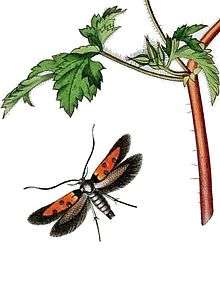Chrysoclista linneella
| Chrysoclista linneella | |
|---|---|
 | |
| Illustration from John Curtis's British Entomology | |
| Scientific classification | |
| Kingdom: | Animalia |
| Phylum: | Arthropoda |
| Class: | Insecta |
| Order: | Lepidoptera |
| Family: | Agonoxenidae |
| Genus: | Chrysoclista |
| Species: | C. linneella |
| Binomial name | |
| Chrysoclista linneella (Clerck, 1759) | |
| Synonyms | |
| |
Chrysoclista linneella, (common names include Linnaeus's spangle-wing, linden bark borer and cosmet) is a moth of the Agonoxenidae family. It is found in most of Europe, in all of the Baltic and Fennoscandian countries, Great Britain, the Netherlands, Belgium, Luxembourg, Germany, Poland, Czech Republic, Slovakia, Hungary, Austria, Slovenia, Switzerland, France, Spain, Italy, Romania, Russia, Turkey and Ukraine. Furthermore, it is an introduced species in North America, where it was first reported in New York City in 1928. In the United States there are reports and records from other parts of New York State, New Jersey, near Boston, Massachusetts, Connecticut, and Vermont. In Canada, it is only known from Ontario and Nova Scotia.
The wingspan is 10–13 millimetres (0.4–0.5 in). Adults are on wing from May to September.
The larvae feed on Tilia trees and are difficult to locate except for the existence of brownish frass on the surface. They mine the bark of their host plant.
External links
- UK moths
- Fauna Europaea
- The linden bark borer (Lepidoptera: Agonoxenidae) infesting European linden in Nova Scotia